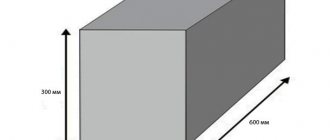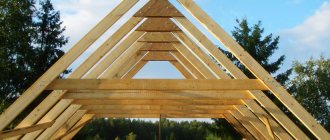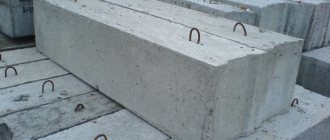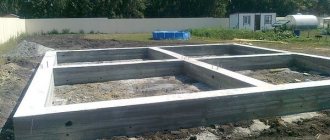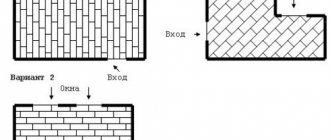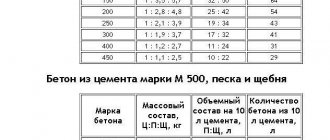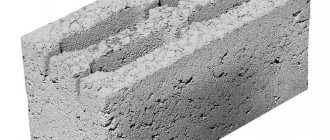Classification of building blocks
Based on the dimensions, a distinction is made between small-sized and large-sized products. The former are characterized by low strength and poor thermal conductivity. The second - high strength characteristics and good thermal insulation properties. The main component of products of any group is concrete. Different types of building blocks differ in price, depending on the type of filler and manufacturing technology.
The following types of concrete building blocks are distinguished:
- Sand concrete;
- Aerated concrete;
- Expanded clay concrete;
- Foam concrete;
- Gas silicate;
- Arbolite;
- Polystyrene concrete;
- Ceramic;
- Slag concrete.
The products are used in the construction of all kinds of buildings - from private houses to industrial buildings. Foundations, internal and external walls, and partitions are built from them. The most commonly used blocks are sand concrete, gas silicate, expanded clay concrete, foam concrete, and polystyrene concrete.
Sand concrete blocks
These products have many positive qualities, but at a fairly low price. They contain cement mortar and coarse sand in a ratio of 1:3. By adding a certain part of Portland cement, the products are given additional density, frost resistance, and resistance to corrosion damage.
The blocks are endowed with high density, sufficient frost resistance (50 cycles), and are durable. The disadvantages include the large mass, which creates a high load on the base, and the need for additional insulation. Models of products are distinguished depending on the purpose: solid for foundations, hollow for masonry walls, for partitions, facing types.
Expanded clay concrete products
These products are made using expanded clay. Different types of such building blocks have their own sizes, which depend on their purpose. The most popular dimensions are 19x39x9 cm or 19x39x18.8 cm. One block of expanded clay concrete replaces 3-7 pieces. standard brick.
The optimal density of the material is 500-1800 kg/cmᶾ. The products have a high strength coefficient and good sound insulation properties. They are used in both civil and industrial construction.
Video - What mistakes to avoid when laying aerated blocks?
Video - Types and features of gas blocks
Video - Difference between autoclaved gas blocks and non-autoclaved ones
Sources
- https://1beton.info/vidy/gazobeton/razmer-gazobloka-dlya-stroitelstva-doma-dlya-peregorodok-standart-gabarity
- https://TvoiDvor.com/beton/razmeryi-gazobetonnyih-blokov-dlya-stroitelstva/
- https://beton-house.com/vidy/gazobeton/razmery-blokov-gazobetonnyh-129
- https://ResForBuild.ru/beton/gazobeton/razmer-bloka-gazobetona.html
- https://stroychik.ru/strojmaterialy-i-tehnologii/gazobetonnye-bloki
- https://cementim.ru/gazobetonnye-bloki/
- https://www.calc.ru/Razmery-Gazobetonnykh-Blokov.html
- https://stroy-podskazka.ru/gazobeton/razmery-gazobloka/
- https://1beton.info/vidy/gazobeton/tolshhina-gazobetona
- https://sdelat-dom.ru/stroitelstvo/steny/gazobetonnye-bloki/
- https://stroyday.ru/stroitelstvo-doma/stroitelnye-materialy/gazobloki-razmery-i-ceny-za-shtuku.html
Gas silicate blocks
These products are widely in demand. The composition, in addition to cellular gas silicate concrete, includes quartz sand, quicklime, and aluminum powder. The popularity of gas silicate blocks is explained by their unique properties:
- Light weight, allowing you to build a house that creates minimal pressure on the foundation.
- Low thermal conductivity due to which the inside of the house will always be warm.
- Variety of shapes.
- Ease of processing.
- Fire safety.
- Fire resistance.
The disadvantage of gas silicate is low density, hygroscopicity, and fragility. Buildings with more than two floors cannot be erected from this material. To strengthen the structure of these types of building blocks, steel reinforcement is used for walls. The dimensions of the gas silicate blocks are 62.5x50x25 cm - ordinary, 62.5x37.5x25 cm - tongue-and-groove, 50x37.5x25 cm - U-shaped.
Foam block
This material is the product of a technological process, the result of which is the connection and mixing of components such as sand, water, cement. Everything is brought to a homogeneous consistency. The mixture is then cut and shaped, and the molds are exposed to air to harden. Such measures increase the strength of foam blocks.
The technology for manufacturing foam blocks does not involve the use of construction equipment. Today, most often such material is produced in dubious workshops, so blocks of low quality end up on the market.
The article describes the dimensions and price of cinder blocks per piece, which is important information when choosing a building material.
The advantages of foam block include:
- Reliability, absence of rotting and molding processes. Thanks to the weight, the load-bearing load of walls and partitions is reduced.
- Low thermal conductivity, which makes it possible to accumulate thermal energy in the house.
- A healthy microclimate that is not afraid of temperature changes.
- Excellent sound insulation performance.
- Fire safety.
- Environmental friendliness, which means that the material does not release harmful substances into the environment. Only wood can compare with this material.
- Wide range of use. This material can be used to increase heat and sound insulation, insulate a house, and floor coverings.
You can learn about all the pros and cons of an aerated concrete block here by reading the article.
The video shows the advantages of foam blocks:
Foam concrete blocks
These lightweight building blocks have 4 types, the characteristics of each depend on the brand of material:
- Thermal insulation grades include D-150-D400 with a density of 150-400 kg/mᶾ;
- For structural and thermal insulation - grades D500-D900, having a density of 500-900 kg/mᶾ;
- The structural category includes grades D1000-D1200, with a density of 1000-1200 kg/mᶾ;
- Structural porous foam blocks are grades D1300-D1600, their density is in the range of 1300-1600 kg/mᶾ.
The latest type of foam blocks is produced in small batches, so their characteristics are not listed in GOST. The starting materials for the production of foam blocks are cement, sand and foaming agents. They are poured into molds and kept until completely hardened.
Polystyrene concrete blocks
This is one of the types of composite materials. They contain several components - water, Portland cement, polystyrene granules, fine sand, plasticizers. The presence of polystyrene determines the high characteristics of the material:
- Hydroscopicity. Absolutely not afraid of water and moisture;
- Thermal conductivity. The indicators are better than analogues made from aerated concrete and foam concrete;
- Heat and energy efficiency. The best indicators from the listed blocks.
Wall and partition types of building blocks used for building a house have a full or hollow structure. Their overall dimensions range from 28.8-62.5 cm in length, 0.92-38 cm in thickness, 8.8-38 cm in height.
The weight of blocks for erecting walls is 5-35 kg, partitions are 5-15 kg. Polystyrene concrete has good bending and tensile strength parameters. As a result, the material has good ductility and does not crack during shrinkage. It is resistant to mold and rot. Structures made of polystyrene concrete blocks do not need additional insulation; they do not need waterproofing, since the water absorption coefficient is quite low.
When choosing blocks for building a house, you should proceed from their performance characteristics and price. Only if the material is chosen correctly will a comfortable microclimate reign in the house.
Wall thickness for different regions
It is better for a specialist who knows all the standards and requirements to calculate the thickness of the internal and load-bearing walls to be able to take into account the features and nuances. Usually, when choosing thickness, they are guided by the required heat saving and strength indicators. The main calculations concern load-bearing walls; internal non-load-bearing partitions can be made thinner.
General advice from experts is as follows: for middle regions (Moscow and nearby cities) a standard 40 centimeters of thickness is enough, in warm regions they take 30 centimeters as a basis, in cold ones - from 50 centimeters. But these are fairly average indicators; it is advisable to focus on the most accurate calculations.
It is customary to take the following data as a basis: for central Russia, the heat transfer resistance of walls, according to SNiP, should be equal to 3.2 W/m*C. For colder regions the indicator is higher, respectively, for warmer regions it is lower. The required level of thermal protection (indicated in 3.2) is given by the following options: 30 centimeters of wall thickness from D300 blocks, 40 centimeters from D400, 50 centimeters from D500.
The overall thermal efficiency of a building is affected by the thickness of the walls, insulation (not only the walls, but also the ceilings, roofing, floors, reinforced belts, windows, lintels). Through insufficiently thick walls, the building loses about 30-40% of heat. For houses with permanent residence, the choice of D400/D500 blocks and a wall thickness of up to 40-50 centimeters is considered optimal. A country house can be built from D400 brand blocks with a wall thickness of 25-30 centimeters.
If you plan to insulate the walls, they can be thinner. Here it is important to ultimately obtain the proper thermal protection indicator, based on the values of aerated concrete and the selected insulation (it can be polystyrene foam, mineral wool, etc.). Thus, the cost of insulation increases, but the cost of aerated concrete decreases.
The higher the thermal protection value of the material, the better. The indicators are shown in the table:
This is a table with the thermal conductivity coefficients of aerated concrete of different brands (the lower the better, the rule works here):
To understand the algorithm for performing calculations, you can consider the following example. If you want to build a house in Moscow and its environs, the thermal resistance should be R=3.28. Autoclaved aerated concrete D500 with a thickness of 30 centimeters is used, insulation is used. How to find the required parameter:
- The thickness of an aerated concrete wall (0.3 meters) is divided by the thermal conductivity coefficient of grade D500 (0.14) - the thermal resistance of a bare wall is R=0.3/0.14=2.14 m2*C/W.
- You need to subtract the resulting indicator from the desired value: 3.28-2.14 = 1.14. This is the thermal resistance of the insulation.
- Mineral wool, for example, gives a thermal conductivity coefficient of 0.04. If you multiply 0.04 by 1.14, you get the required insulation thickness: 0.04x1.14=0.0456=45 millimeters=4.5 centimeters. That is, the thickness of the insulation for walls of 30 centimeters should be about 5 centimeters.
Knowing the standard values, you can easily perform calculations for any brand of aerated concrete blocks and types of insulation.
